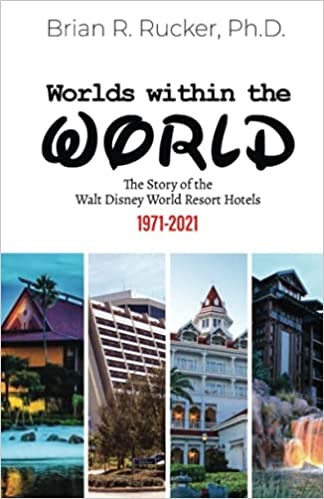Category — A Friday Visit with Jim Korkis
Fridays with Jim Korkis: Golden Oak Walt Disney World
Welcome back to Fridays with Jim Korkis! Jim, the dean of Disney historians, writes about Walt Disney World history every Friday on yourfirstvisit.net.
GOLDEN OAK AT WALT DISNEY WORLD
By Jim Korkis
Golden Oak is a 980 acre upscale residential community within the Walt Disney World Resort itself. It was designed by Walt Disney Imagineering and is owned and operated by a newly formed Disney subsidiary, Golden Oak Realty.
The name was inspired by Walt Disney’s Golden Oak Ranch in Newhall, California, where he filmed several movies and television shows. Imagineering states that the name refers to gold nuggets discovered under an oak tree on that ranch property in 1842.
Most homes in Golden Oak are multimillion-dollar properties (starting at two million and going up to ten million or more) aimed at the highly affluent who want to “live in the magic” in luxury and privacy. Nightly fireworks from the Magic Kingdom less than four miles away can be seen, and heard, from all of the homes.
There are multiple lakes throughout the community, as well as a small river, meaning that some of the properties are technically classified as lake-front. The first few homes were available for purchase in late 2010 and completed in late 2011. Disney said the gated community will eventually have over 300 homes. Home sizes range from 3,000 to 12,000 square feet.
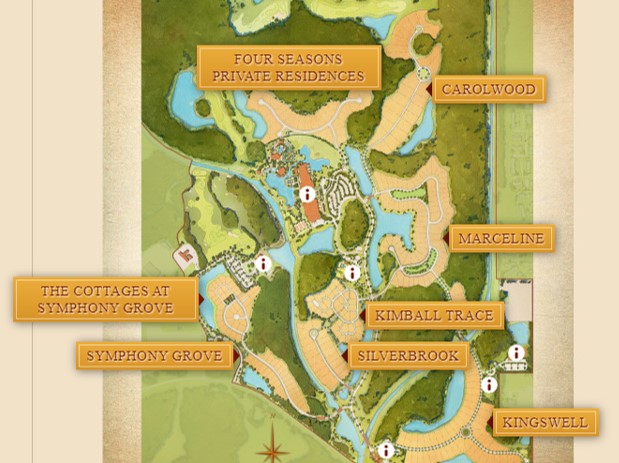
(c) Disney
The property is divided into several distinct neighborhoods: The Cottages at Symphony Grove, Kingswell, Carolwood, Kimball Trace, Marceline and Silverbrook. Those names reflect Disney heritage. Walt Disney used to live in Marceline, Missouri and on the streets of Kingswell and Carolwood in California. Kimball refers to Disney animator and Imagineer Ward Kimball and Symphony calls to mind the Silly Symphony cartoon series.
The homes are inspired by Mediterranean, Caribbean, Venetian, Dutch, Island Colonial and Tuscan styles. Imagineering developed the associated architectural style guidelines. Homeowner fees range from $10,000 to $12,000 a year.
Golden Oak blends the residential area with a commercial area that includes the 443-room five-star Four Seasons Resort, restaurants, spa with whirlpool, tennis facility, a pool and the Summerhouse, a 17,000 square foot private recreational clubhouse for residents that is located in the center of the community. In addition, the area includes the eighteen hole Tranquilo championship golf course designed by Tom Fazio.
The two restaurants in Summerhouse are named Markham’s, after the Marty Markham character on Spin and Marty, a Disney series on the original 1950s Mickey Mouse Club television show, and Bolton’s, named for Fred Bolton, the lead character in the 1968 Disney movie The Horse in the Gray Flannel Suit.
Residents receive certain benefits from Disney such as merchandise delivery, assistance with dining reservations, and transportation to and from the parks. The chefs at Four Seasons hotel are on call twenty-four hours a day, seven days a week, to come and cook at a resident’s home.
The community is full of Disney inspired things like bronze statues of characters including Snow White and the Seven Dwarfs, Bambi, Thumper and more. Many of the custom mansions bring the Disney decor inside, like a home built to resemble the Haunted Mansion ride at Magic Kingdom, or one in which guests walk through a small door to enter a shrunken room just like in the animated feature Alice in Wonderland.
There are more Disney references at the Golden Oak complex but I have not personally been able to verify some that I heard exist. I am more likely to be found picking up a bargain happy meal than eating at a five star restaurant on that property or longingly looking through the gates.
* * * * *
Thanks, Jim! and come back next Friday for more from Jim Korkis!
In the meantime, check out his books, including his new books Vault of Walt: Volume 10: Final Edition, Kungaloosh! The Mythic Jungles of Walt Disney World and Hidden Treasures of Walt Disney World Resorts: Histories, Mysteries, and Theming, much of which was first published on this site.
Follow yourfirstvisit.net on Facebook or Twitter or Pinterest!!
November 5, 2021 No Comments
Fridays with Jim Korkis: Worlds Within the World
Welcome back to Fridays with Jim Korkis! Jim, the dean of Disney historians, writes about Walt Disney World history every Friday on yourfirstvisit.net.
YOUR PERSONAL DISNEY LIBRARY (45)
By Jim Korkis
- Worlds Within the World by Brian Rucker
I tell people that the hardest thing is not researching and writing a book but after it is published letting people who might be interested know that it even exists. Today, the market is flooded with Disney related books, and there are many more coming each month.
As a result, sometimes an interesting book will not receive any publicity and go unnoticed by readers who might enjoy it. Worlds Within the World certainly fits that description.
Having just recently authored a book called Hidden Treasures of the Walt Disney World Resort Hotels, I was more than curious to immediately purchase this book that I had never even heard was in development.
If you are curious, too, let me tell you that Worlds Within the World is well-written, accurate and includes material that is not in my book including sections on Golden Oak, ESPN Wide World of Sports, Disney’s Skyliner and more because of their proximity to the resorts.
While my book spends more time digging into the elaborate back stories and theming detail at the resort hotels, Rucker’s book does share a brief overview of some of that same material.
Like me, his intent was not to write a book about getting discounts, finding the best room location, the best time to book a reservation and similar things that guests immediately think of when planning a vacation. We both want to enhance the story of the resort itself that is often overlooked by guests rushing to the parks.
I feel I should also point out that Rucker frequently references my work in books and articles (including ones done for this website) but he also references Lou Mongello, Jim Hill, Mike Lee, Birnbaum, David Koenig, Beth Dunlop, Jeff Kurtti, Chuck Mirarchi, Jack Spence, Debra Martin Koma and many other recognizable and respected authorities on Walt Disney World in his thirty-thirty pages of notes as well as a twenty-three page bibliography.
Dr. Brian Rucker is a professor of history at Pensacola State College and he also teaches Florida history at the University of West Florida. He has authored or edited over fifty scholarly books none of which seem to be offered on Amazon and articles related to Florida and the Gulf Coast history.
Rucker started visiting Walt Disney World with his family as a child in the spring of 1972 and has made frequent return visits. This personal experience is clearly evident in his text.
As he states in his introduction to Worlds Within the World, “I have witnessed the worlds with the World that each of these resorts offer. Each one has its own ambience, its own charm, its own character. I have personally stayed at twelve of the Walt Disney World resorts and I have visited every one of them. I understand firsthand the experience that Disney was trying to impart with the creation of the Vacation Kingdom.”
The book is nicely arranged into six chapters (Magic Kingdom Resorts, Epcot Area Resorts, Disney Springs Resorts, Disney’s Hollywood Studios Resorts, Disney’s Animal Kingdom Resorts and This, That and the Future). In each chapter are several short individual sections devoted to a topic, primarily a resort hotel but there are others that spotlight the water parks, the Walt Disney World Casting Center, the Walt Disney World Team Building and more.
So much more needs to be written about the WDW resort hotels and while I hope you buy my book to learn more, I highly recommend buying this book to add to your collection especially as we celebrate the 50th anniversary of Walt Disney World.
* * * * *
Thanks, Jim! and come back next Friday for more from Jim Korkis!
In the meantime, check out his books, including his new books Vault of Walt: Volume 10: Final Edition, Kungaloosh! The Mythic Jungles of Walt Disney World and Hidden Treasures of Walt Disney World Resorts: Histories, Mysteries, and Theming, much of which was first published on this site.
Follow yourfirstvisit.net on Facebook or Twitter or Pinterest!!
October 29, 2021 No Comments
Fridays with Jim Korkis: Pin Trading at Walt Disney World
Welcome back to Fridays with Jim Korkis! Jim, the dean of Disney historians, writes about Walt Disney World history every Friday on yourfirstvisit.net.
WALT DISNEY WORLD PIN TRADING
By Jim Korkis
Limited Disney pin trading has returned to Walt Disney World with certain restrictions.
Disney buttons and pins have existed for decades. I can still clearly remember the excitement in 1986 when Coca-Cola, to celebrate the 15th anniversary of Walt Disney World, released 60 Disney character pins displayed in a wooden frame with a glass cover. These pins could be purchased separately or in a set.
The Olympic Games offered pins to spectators as early as 1912 and continued to do so for decades along with other sporting events. Sometimes special venues like hot air balloon festivals also having pin trading. Disney executives attended some of these venues in the mid-1990s before deciding to try to market pins.
It was at Walt Disney World that Disney Pin Trading as we know it today officially began. It was meant to be a temporary offering during the Millennium Celebration starting in October 1999 that included the debut of Pin Central at Epcot as the first dedicated Disney Pin Trading location.
This was all under the direction of Ed Storin who at the time was Manager of Special Events and was working closely with Epcot for the upcoming celebration.
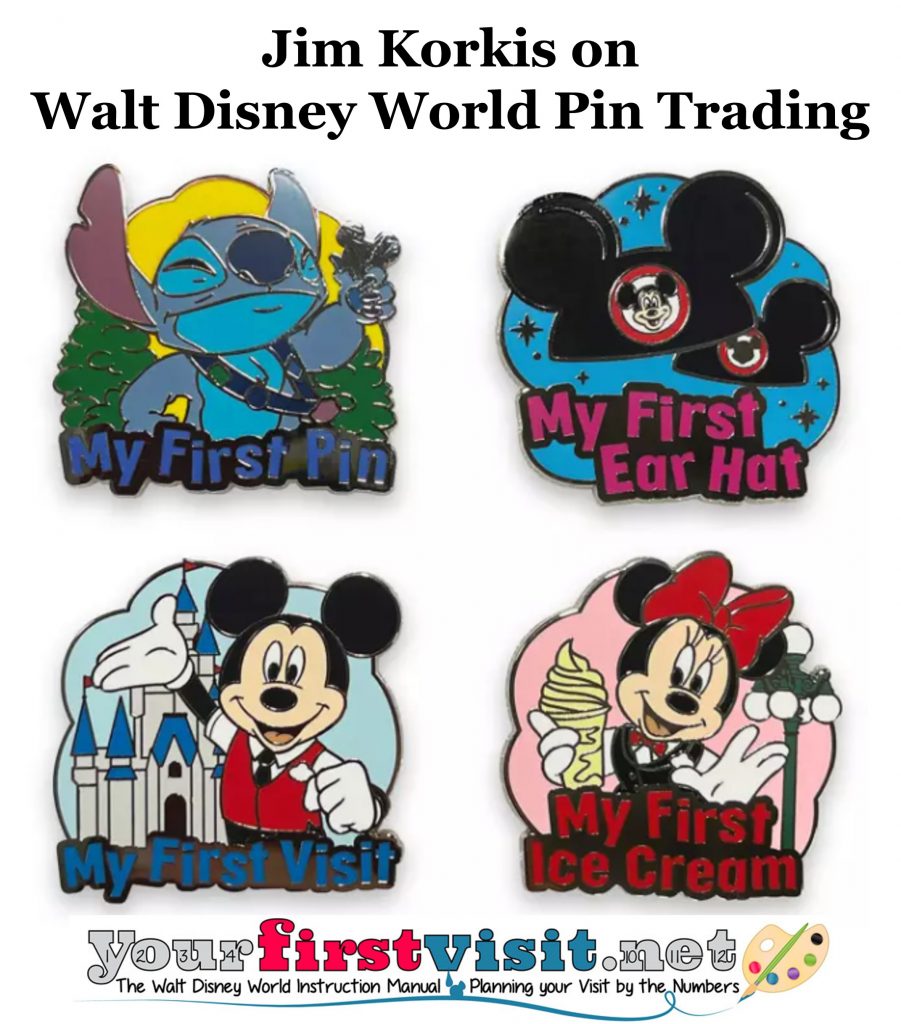
Pin trading is the activity of making a mutually agreeable exchange of one Disney pin for another, usually at some Disney location like a theme park or an event. Disney “pin etiquette” says that a “tradable” pin is one that is “a cloisonné, semi-cloisonné or hard-enamel metal Disney pin” that includes the Disney copyright.
As long as the criteria are met, cast members are required to trade with a guest.
Jim Greene led a team for two to three years to set the guidelines and rules for pin trading. Greene said, “It wasn’t about just selling our guests a pin. It was about engaging guests so we gave guests on a hotel package a free, flex ‘Celebrate the Future Hand in Hand’ pin in 2000 that was fairly unattractive.
“We told them they could trade it with cast members with a black lanyard for another pin they wanted. So the adventure started. Over the course of eighteen months we gave out one and half million of the free pins.”
There have been too many pins produced over the decades (including ones exclusively for cast members) to collect them all, so generally a Disney collector might limit the collecting to a particular character, theme or film. New pins can become available weekly and older ones go out of production quickly. In fact, the pins released from 1990 to 2010 are often worth a lot more than the newer ones released today.
Primarily, the Disney Design Group was responsible for the pin images, and on average it took 180 to 200 days to turn a Disney pin concept into a reality to be sold.
The most expensive pin made was a Dream Jeweled Mickey Mouse pin covered in 130 different semi-precious stones that retailed for $1,295 and was released in a limited edition of three.
“We found the more pins we put out, the more guests and cast wanted to trade,” said Storin. “Cast members got excited because they became pin collectors and traders themselves. It became more than just merchandise. It was about the experience. Pin trading became like an attraction.”
Thanks, Jim! And come back next Friday for more from Jim Korkis!
In the meantime, check out his books, including his new books Kungaloosh! The Mythic Jungles of Walt Disney World and Hidden Treasures of Walt Disney World Resorts: Histories, Mysteries, and Theming, much of which was first published on this site.
Follow yourfirstvisit.net on Facebook or Twitter or Pinterest!!
October 22, 2021 No Comments
Fridays with Jim Korkis: Ariel’s Grotto
Welcome back to Fridays with Jim Korkis! Jim, the dean of Disney historians, writes about Walt Disney World history every Friday on yourfirstvisit.net.
ARIEL’S GROTTO
By Jim Korkis
In the animated feature The Little Mermaid (1989), Ariel had her own private underwater rock cavern filled with her vast trove of treasures that she had retrieved from the human world. It is where she sings the iconic song, Part of Your World.
That special location was duplicated at several Disney theme parks.
At Disneyland, it was located where the Alpine Gardens in front of Tomorrowland formerly resided. Opened in 1996, it was a meet-and-greet location decorated with starfish, coral, a bronze statue of Ariel and waterfalls.
It was especially notable for a huge King Triton fountain where water spurted from his trident and led to the grotto area where Ariel sat inside a large clamshell. It closed in 2008 to make way for Pixie Hollow.
Tokyo DisneySea had a meet-and-greet attraction called Ariel’s Greeting Grotto that opened April 15, 2005 and closed January 2020, but was reopened later that year as Mermaid Lagoon Theater for socially distanced encounters with Ariel as a mermaid.
At Disney California Adventure, Ariel’s Grotto opened February 2001 as an “under the sea” themed restaurant that gave guests an opportunity to dine with Ariel and other Disney Princesses in “Ariel’s Disney Princess Celebration”. The restaurant was located on Paradise Pier, and featured an upscale menu. On January 8th, 2018, Ariel’s Grotto closed to make way for the Lamplight Lounge.
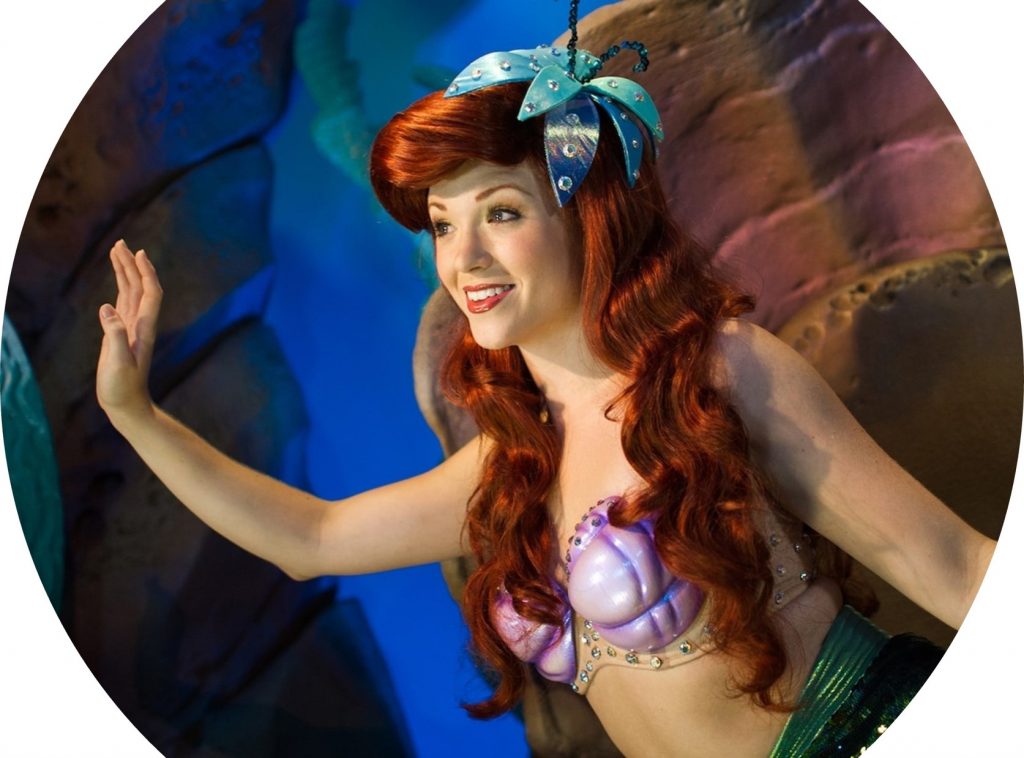
(c) Disney
For Walt Disney World guests, Ariel’s Grotto meant the meet-and-greet area at the far end of the lagoon area that formerly housed the 20,000 Leagues Under the Sea: Submarine Voyage attraction. A large King Triton spouting statue marked the location until April 2010.
There was also a children’s play area nearby with a spongy flooring because originally there were squirting fountains but those were turned off the last few years of its existence.
Ariel’s Grotto was later incorporated into an area beside the Under the Sea: Journey of the Little Mermaid attraction. In a cave next to Prince Eric’s Castle surrounded by waterfalls and large rock formations, Ariel greets guests on a padded bench decorated with appropriate nautical details like a variety of shells.
This is the only place at Magic Kingdom or any other Walt Disney World parks to meet Ariel as a mermaid.
Meets ended in March 2020. Some are returning in modified fashion in November 2021, but so far it is not clear that Ariel’s Grotto will be one of them.
The official Walt Disney World website declares: “Venture into a seaside grotto, where you’ll find Ariel among her treasures. She has gadgets and gizmos aplenty, and she’s always happy to make new friends—especially human ones. She wants to be where the people are, so stop by and make her dream come true!”
At Prince Eric Village Market, a food and beverage location, directly across from Ariel’s Grotto, starting in 2018, a Mermaid Donut was introduced. The sugary treat is covered in purple icing with sprinkles and decorated with white chocolate shells and a sand dollar. A mermaid’s green tail is captured mid-splash in the center of the donut.
Prince Eric’s Village Market also sells other Little Mermaid inspired food offerings including Dinglehopper Noodles and Dream Big, Little Mermaid Oyster Cake that are only available at that location.
Thanks, Jim! For more from Jim on The Little Mermaid in the Disney parks, see this, and I have a review of Under the Sea: Journey of the Little Mermaid here.
And come back next Friday for more from Jim Korkis!
In the meantime, check out his books, including his new books Kungaloosh! The Mythic Jungles of Walt Disney World and Hidden Treasures of Walt Disney World Resorts: Histories, Mysteries, and Theming, much of which was first published on this site.
Follow yourfirstvisit.net on Facebook or Twitter or Pinterest!!
October 15, 2021 No Comments
Fridays with Jim Korkis: Under the Sea — Journey of the Little Mermaid
Welcome back to Fridays with Jim Korkis! Jim, the dean of Disney historians, writes about Walt Disney World history every Friday on yourfirstvisit.net.
UNDER THE SEA: JOURNEY OF THE LITTLE MERMAID
By Jim Korkis
When the animated feature film The Little Mermaid debuted in theaters in 1989, it was a massive critical and financial success, and Imagineers immediately began developing ideas for an attraction.
One plan for a dark ride for Disneyland Paris designed by Imagineer Tony Baxter was included as an “extra” in the 2006 Platinum Edition DVD of The Little Mermaid. It was also announced that there would be Little Mermaid attractions at Tokyo DisneySea and Hong Kong Disneyland.
However, for a variety of reasons, none of these proposals became a reality. Ariel’s presence in the parks was primarily limited to parades, character meets, and the Voyage of The Little Mermaid show at Disney’s Hollywood Studios.
It wasn’t until June 3, 2011 that guests were finally able to journey under the sea with The Little Mermaid: Ariel’s Undersea Adventure attraction which debuted at Disney California Adventure.
In 2014, several enhancements were made including adding new sea creature figures throughout the ride, a view of King Triton’s castle, and the “Under the Sea” scene was given a blacklight treatment. The Ariel and Prince Eric figures’ sculpted hair was replaced with realistic hair in the “Kiss the Girl” and “finale” scenes.
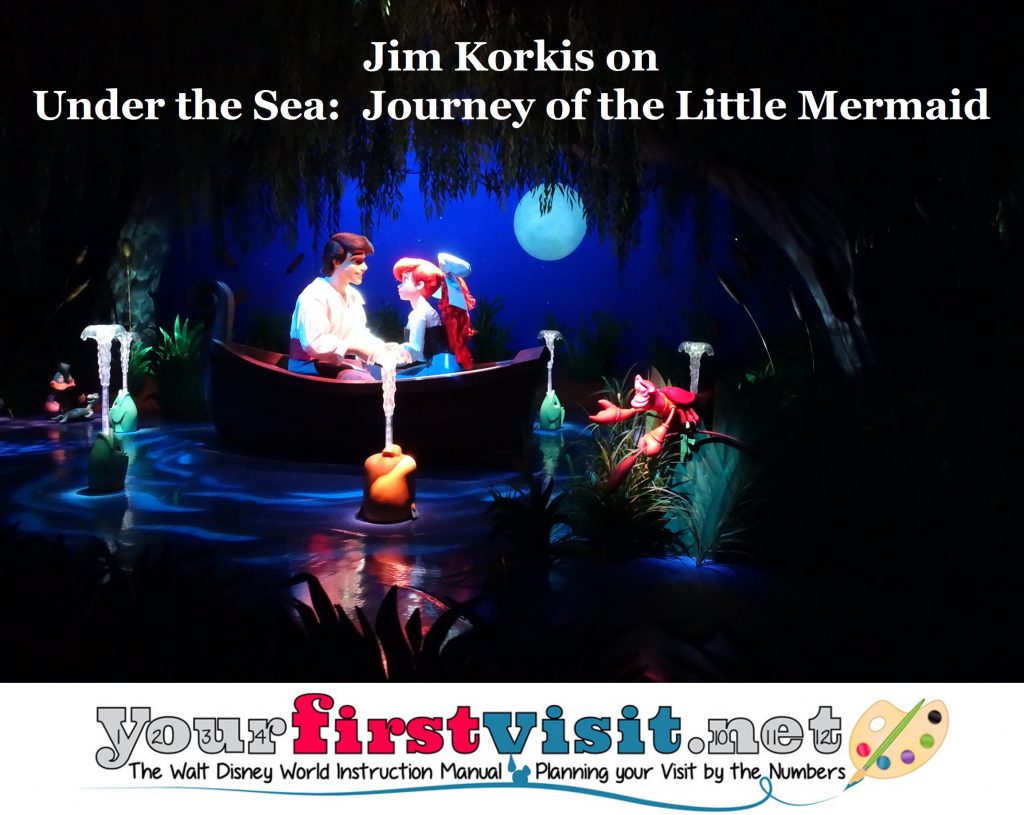
One of the reasons for the difference in the name of the WDW attraction is that is built on the same spot of land that once featured the 20,000 Leagues Under the Sea attraction. Homage to that attraction can be found in an imprint of the classic Nautilus submarine on one of the rock formations before entering the attraction.
When the submarine attraction closed in 1994, Imagineers bottled up some of the attraction’s water and carefully labeled and stored it for almost twenty years. During the official event for the new attraction’s opening, the bottles were opened and poured into its waters.
Under the Sea: Journey of the Little Mermaid is a standard Disney “dark ride,” where guests in vehicles travel through scenes from a classic Disney animated film. In this case, the vehicles are ominmover pastel-colored clamshells that transport guests on a winding track for approximately five and a half minutes (twice the time of Peter Pan’s Flight) from the time guests board the clamshell to the time they exit the clamshell.
As the vehicle turns and tilts backward, bubble effects projected on the clamshell in front of you, and a rush of cool air provides the illusion of going “under the sea” into the story of Ariel.
Senior Show Producer Lisa Girolami explained, “We had to create more of the ‘Under the Sea’ [scene], because those are very short little clips in the film. There are 128 animated characters in this scene, ranging in complexity from a whirling octopus and a lifelike Sebastian figure, to fish that bob back and forth and 50 sea stars that spin on the coral. There are 183 character figures in the attraction with more than 70 percent just in this scene.”
As they were developing the attraction, the Imagineers brought in co-directors of the film John Musker and Ron Clements as well as Ariel’s animator Glen Keane to consult and they agreed to the final scene where Eric and Ariel are married and waving to their subjects and friends because of the spatial restrictions of the attraction.
One of the most impressive Hidden Mickeys in Walt Disney World is located within this attraction’s queue. It can only be seen on Mickey Mouse’s birthday, November 18 at noon! Disney Imagineers carved part of the rock formation in the queue to allow the sun to shine through on the dark rock wall. This special birthday Hidden Mickey can only be seen for about seven minutes.
* * * * *
Thanks, Jim! I have a review of Under the Sea: Journey of the Little Mermaid here.
And come back next Friday for more from Jim Korkis!
In the meantime, check out his books, including his new books Kungaloosh! The Mythic Jungles of Walt Disney World and Hidden Treasures of Walt Disney World Resorts: Histories, Mysteries, and Theming, much of which was first published on this site.
Follow yourfirstvisit.net on Facebook or Twitter or Pinterest!!
October 8, 2021 No Comments
Fridays with Jim Korkis: Soarin’ Around the World
Welcome back to Fridays with Jim Korkis! Jim, the dean of Disney historians, writes about Walt Disney World history every Friday on yourfirstvisit.net.
SOARIN’ AROUND THE WORLD IN EPCOT
By Jim Korkis
Soarin’ Over California was an opening day attraction at Disney California Adventure on February 8, 2001. The original five minute version took guests over several locations in California and included a pre-show tribute to the history of California’s aviation industry.
It was all meant to theme with the Condor Flats and Grizzly Peak Airfield section of the park, in a building that was like a huge hangar similar to what might be found at a medium sized municipal airfield.
Soarin’ opened at Epcot on May 5, 2005 in the Land pavilion, and while it used the same film as the one in Anaheim, the story was that guests were boarding a flight TO California on “Flight 5505” a reference to opening day of the Epcot attraction. It quickly became the most popular experience at Epcot.
“The Soarin’ building at Epcot features a strong airport and travel theming,” said John Leloudis, Director of Architecture and Engineering for Walt Disney Imagineering. “In our story, you’re traveling to parts of California. Your journey starts from our entry rotunda where you will see an information desk and airport security portals.
“Once you pass the security checkpoints, you enter the concourse leading to your gates. Before each gate is a pre-show area in which you will be given a safety presentation related to your flight and what you are about to experience. The attraction at Disney California Adventure has more of an aviation history theme.”
Another difference is that the California attraction’s foundation is buried 23 feet below ground but the Florida crew placed the Epcot foundation only 10 feet in the ground for the seven story high building that takes up roughly 60,000 square feet of space.
Leloudis said, “I think the uniqueness of this attraction is that guests are immersed in the environment through the powerful imagery of the movie scenes, coupled with incredibly smooth movement.
“It will give guests the feeling and experience that they are in a hang glider and soaring in space. Guests will experience the motion of gliding through air, over mountaintops, ocean and orange groves, feeling wind on their faces and smelling orange groves and pine trees. It’s as close as you can get to hang gliding without actually doing it.
“Once you enter the theater itself, you see a powerful and massive piece of machinery that will lift 90 guests in the air at the same time. The theater features a huge eighty-foot IMAX screen designed especially for this attraction. It’s quite a sight. The building design camouflages its massiveness and it is truly a huge volume of space.”
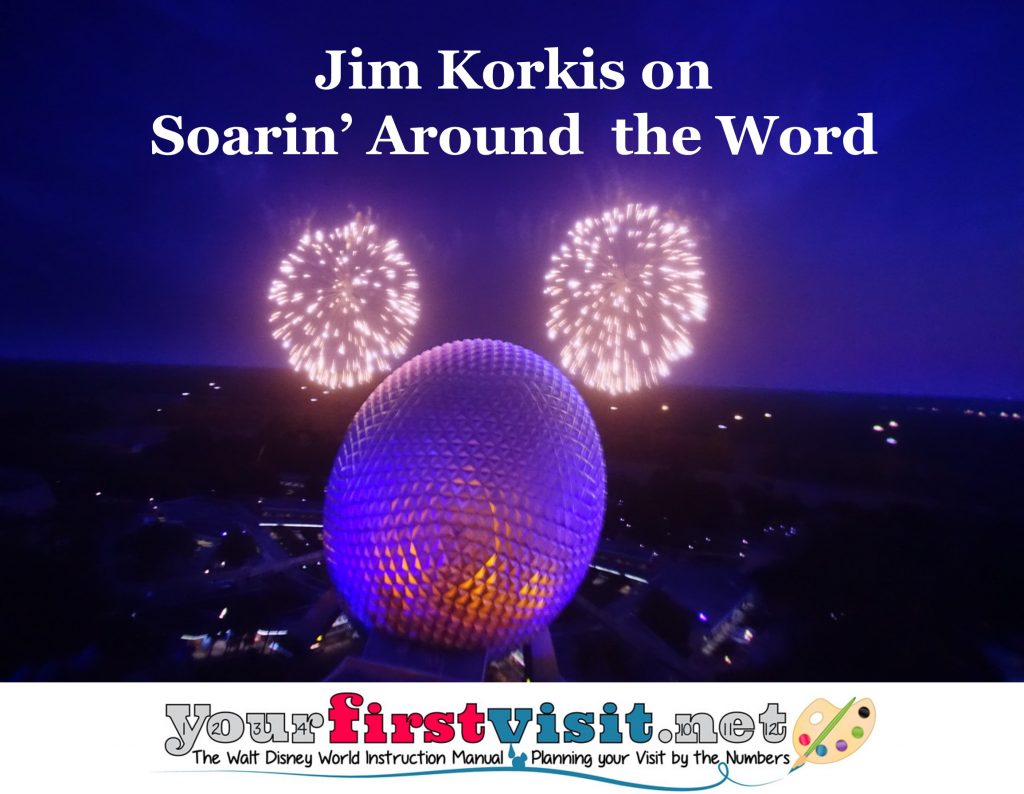
Soarin’ Around the World features locations, landscapes, and landmarks across six continents of the world with the final scene taking place over Epcot. The famous “orange scent” going over orange groves is gone, replaced by the smell of red roses during the Taj Mahal scene.
Unlike the original ride film, Soarin’ Around the World heavily features computer generated imagery including animated transitions between scenes. The Taj Mahal scene is completely computer generated.
The new score is adapted from the Jerry Goldsmith music for the original attraction by composer Bruce Broughton. The score was recorded by the London Studio Orchestra at the historic Abbey Road Studios in London, and features instruments from around the world that complement the orchestra score, giving it an international flavor.
* * * * *
Thanks, Jim! I have a review of Soarin’ Around the World here. The new version is hard to like compared to the original…
And come back next Friday for more from Jim Korkis!
In the meantime, check out his books, including his new books Kungaloosh! The Mythic Jungles of Walt Disney World and Hidden Treasures of Walt Disney World Resorts: Histories, Mysteries, and Theming, much of which was first published on this site.
Follow yourfirstvisit.net on Facebook or Twitter or Pinterest!!
October 1, 2021 No Comments


